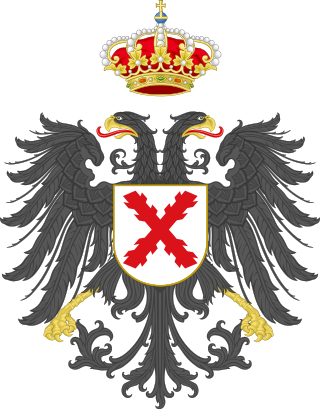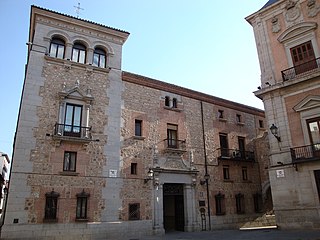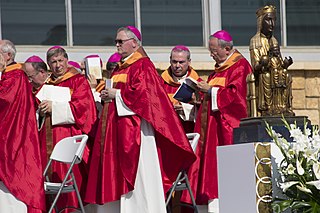Contents
This article needs additional citations for verification .(February 2024) |
| |||||
| Decades: | |||||
|---|---|---|---|---|---|
| See also: | Other events of 1868 List of years in Spain | ||||
Events in the year 1868 in Spain .
This article needs additional citations for verification .(February 2024) |
| |||||
| Decades: | |||||
|---|---|---|---|---|---|
| See also: | Other events of 1868 List of years in Spain | ||||
Events in the year 1868 in Spain .

Isabella II was Queen of Spain from 1833 until her deposition in 1868. She is the only queen regnant in the history of unified Spain.

The Carlist Wars were a series of civil wars that took place in Spain during the 19th century. The contenders fought over claims to the throne, although some political differences also existed. Several times during the period from 1833 to 1876 the Carlists—followers of Don Carlos (1788–1855), an infante, and of his descendants—rallied to the cry of "God, Country, and King" and fought for the cause of Spanish tradition against liberalism, and later the republicanism, of the Spanish governments of the day. The Carlist Wars had a strong regional component, given that the new order called into question region-specific law arrangements and customs kept for centuries.
Narvaez is a surname of Spanish and also Basque origin, and may refer to:

Ramón María Narváez y Campos, 1st Duke of Valencia was a Spanish general and statesman who served as Prime Minister on several occasions during the reign of Isabella II. He was also known in Spain as El Espadón de Loja, "The Big Sword of Loja".

Francisco Javier de Burgos y del Olmo was a Spanish jurist, politician, journalist, and translator.

Vicente López Portaña was a Spanish painter, considered one of the best portrait painters of his time.

Manuel de Pando y Fernández de Pinedo, 6th Marquess of Miraflores, 4th Count of la Ventosa, GE was a Spanish noble and politician, who served two times as Prime Minister of Spain and held other important political office such as Minister of State and President of the Senate.

Bernardino Fernández de Velasco-Pacheco y Benavides, 14th Duke of Frías, Grandee of Spain,KOGF was a Spanish noble, politician, diplomat and writer who served in 1838 as Prime Minister of Spain. He was one of the most important Spanish nobles of his time, and held, among other titles, the dukedoms of Frías, Escalona and Uceda, the Marquisates of Villena and Berlanga, and the Countships of Alba de Liste, Oropesa and Peñaranda de Bracamonte.
The Liberal Union was a political party in Spain in the third quarter of the 19th century. It was founded by Leopoldo O'Donnell in 1858 with the intent of forging a compromise and taking a centrist position between the two forces that had hitherto dominated Spanish politics during the reign of Isabella II. On one side were the forces of conservative liberalism known as the doceañistas, arrayed around the Moderate Party. Among their leading figures were the queen mother Maria Christina of the Two Sicilies and General Ramón María Narváez. On the other were radical liberal exaltados or veinteañistas arrayed around the Progressive Party and the National Militia. Among their leading figures was General Baldomero Espartero. Both parties had fought on the same side in the Carlist Wars, but they had also at times fought against one another, and elements of the Moderate Party leaned toward absolute monarchy themselves. O'Donnell's intent was to bring together the non-absolutist Moderates and the less "exalted" (radical) Progressives and to occupy the political center. He first came forward with this program in September 1854 a few months after the end of the 10-year reign of the Moderates, but did not succeed in forming a party at that time.

Alejandro Llorente y Lannas was a Spanish politician, writer, journalist and historian who served as Minister of State in 1864, in a cabinet headed by Ramón María Narváez, 1st Duke of Valencia. He was a Knight of the Golden Fleece and Knight Grand Cross of the Order of Charles III.

Alejandro Mon y Menéndez was a Spanish politician and jurist who was prime minister of Spain in 1864, during the reign of Queen Isabella II.

The Casa Cisneros is a palace located on the Plaza de la Villa in Madrid, Spain. Built in Plateresque style in 1537, at the request of Benito Jiménez de Cisneros, a 16th-century architect and nephew of Cardinal Cisneros, it is named in his honor.

The 522 Spanish Martyrs were victims of the Spanish Civil War beatified by the Roman Catholic Church on 13 October 2013 by order of Pope Francis. It was one of the largest number of persons ever beatified in a single ceremony in the Church's 2000-year history. They originated from all parts of Spain. Their ages ranged from 18 to 86 years old.

The reign of Isabella II has been seen as being essential to the modern history of Spain. Isabella's reign spanned the death of Ferdinand VII in 1833 until the Spanish Glorious Revolution of 1868, which forced the Queen into exile and established a liberal state in Spain.

Francisco Armero y Fernández de Peñaranda, Marquess of Nervión and Grandee of Spain was a Spanish Captain general of the Navy and politician.

Ministry of the Navy was a government department of Spain that was tasked with oversight of the Spanish Navy and existed in multiple reincarnations before being finally dissolved in 1977, when its functions were merged with the Ministry of Defence by Adolfo Suárez.

Ángel Fernández de los Ríos was a Spanish politician, journalist, writer and urbanist.

Marquess of Oquendo is a hereditary title in the Peerage of Spain, granted in 1889 by Queen María Cristina in the name of his son Alfonso XIII to José María Narváez, 2nd Duke of Valencia and the nephew of Ramón María Narváez, 1st Duke of Valencia. The name refers to Antonio de Oquendo, an ancestor of the 1st Marquess.
Ramon Terrats Espacio is a Spanish professional footballer who plays as a central midfielder for La Liga club Villarreal.